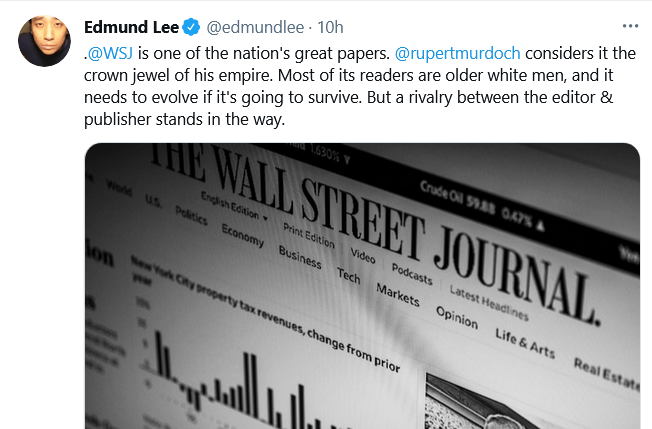From the New York Times news section:
Inside the Fight for the Future of The Wall Street Journal
A special team led by a high-level manager says Rupert Murdoch’s paper must evolve to survive. But a rivalry between editor and publisher stands in the way.
By Edmund Lee
April 10, 2021The Wall Street Journal is a rarity in 21st-century media: a newspaper that makes money. A lot of money. But at a time when the U.S. population is growing more racially diverse, older white men still make up the largest chunk of its readership, with retirees a close second.
“The No. 1 reason we lose subscribers is they die,” goes a joke shared by some Journal editors.
Is the New York Times endorsing the factual validity of the Great Replacement Theory?
No, it’s in favor of the Great Replacement, which means the NYT is good. All that matters these days is who are the good guys and who are the bad guys. Of course, people who know the factual truth, such as by paying a lot of money to subscribe to the WSJ, are likely to make even more money.
But who cares? Money printer go BRRRRRRR.
Now a special innovation team and a group of nearly 300 newsroom employees are pushing for drastic changes at the paper, which has been part of Rupert Murdoch’s media empire since 2007. They say The Journal, often Mr. Murdoch’s first read of the day, must move away from subjects of interest to established business leaders and widen its scope if it wants to succeed in the years to come. The Journal of the future, they say, must pay more attention to social media trends and cover racial disparities in health care, for example, as aggressively as it pursues corporate mergers.
In other words, the Wall Street Journal should abandon its near monopoly on America’s high-earning white male decision-makers and instead compete with Jezebel, The Root, and Teen Vogue for the Woke barista audience.
Sounds like a plan!
It’s like how the Masters golf tournament should have Cardi B perform on the 12th green between shots. Sure, they might lose commercials for why you should buy Boeings instead of AirBuses, but they’d make up for it on volume of spots for weed delivery services.
That argument has yet to convince executives in the top ranks of the company. …
As the team was completing a report on its findings last summer, Mr. Murray found himself staring down a newsroom revolt. Soon after the killing of George Floyd, staff members created a private Slack channel called “Newsroomies,” where they discussed how The Journal, in their view, was behind on major stories of the day, including the social justice movement growing in the aftermath of Mr. Floyd’s death. Participants also complained that The Journal’s digital presence was not robust enough, and that its conservative opinion department had published essays that did not meet standards applied to the reporting staff. The tensions and challenges are similar to what leaders of other news organizations, including The Times, have heard from their staffs.
The obvious solution is to give in to the genius business intuitions of 20-something interns on the staff.
In July, Mr. Murray received a draft from Ms. Story’s team, a 209-page blueprint on how The Journal should remake itself called The Content Review. It noted that “in the past five years, we have had six quarters where we lost more subscribers than we gained,” and said addressing its slow-growing audience called for significant changes in everything from the paper’s social media strategy to the subjects it deemed newsworthy.
The report argued that the paper should attract new readers — specifically, women, people of color and younger professionals — by focusing more on topics such as climate change and income inequality.
After all, where else besides the WSJ can you find content on those topics?
Among its suggestions: “We also strongly recommend putting muscle behind efforts to feature more women and people of color in all of our stories.”
And, of course, more stories about women of color and their hair.
The Content Review has not been formally shared with the newsroom and its recommendations have not been put into effect, but it is influencing how people work: An impasse over the report has led to a divided newsroom, according to interviews with 25 current and former staff members.
The only solution is to increase the race and sex quotas for the kind of employees who are dividing the newsroom. Once all the Bad People are gone, then divisiveness will be over, forever.













